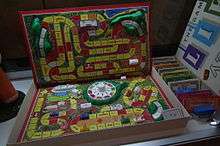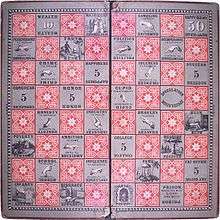The Game of Life
 Japanese-language version of the modern edition of The Game of Life | |
| Designer(s) |
Reuben Klamer Bill Markham |
|---|---|
| Publisher(s) | Milton Bradley Company and Winning Moves |
| Players | 2 to 8 |
| Age range | 9 to adult |
| Setup time | 10 minutes (approx.) |
| Playing time | 45 minutes (approx.) |
| Random chance | High (spinning a wheel, card-drawing, luck) |
| Skill(s) required | Counting, reading |
The Game of Life, also known simply as Life, is a board game originally created in 1860 by Milton Bradley, as The Checkered Game of Life. The Game of Life was America's first popular parlor game.[1] The game simulates a person's travels through his or her life, from college to retirement, with jobs, marriage, and possible children along the way. Two to six players can participate in one game. Variations of the game accommodate eight to ten players.
The modern version was originally published 100 years later, in 1960. It was created and co-designed by toy and game designer Reuben Klamer[2] and was "heartily endorsed" by Art Linkletter. It is now part of the permanent collection of the Smithsonian's National Museum of American History and an inductee into the National Toy Hall of Fame. It later spawned a book, The Game of Life: How to Succeed in Real Life No Matter Where You Land (Running Press), by Lou Harry.
History

The game was originally created in 1860 by Milton Bradley as The Checkered Game of Life. This was the first game created by Bradley, a successful lithographer, whose major product until that time was a portrait of Abraham Lincoln with a clean-shaven face, which did not do well once the subject grew his famous beard. The game sold 45,000 copies by the end of its first year. Like many games from the 19th century, such as The Mansion of Happiness by S. B. Ives in 1843, it had a strong moral message.[3]
Bradley's game did not include dice, instead using a teetotum, a six-sided top. (Dice were considered too similar to gambling.)
The game board was essentially a modified checkerboard. The object was to land on the good spaces and collect 100 points. A player could gain 50 points by reaching "Happy Old Age" in the upper-right corner, opposite "Infancy" where one began.
In 1960, the 100th anniversary of The Checkered Game of Life, the first modern version of The Game of Life, a collaboration between Reuben Klamer and Bill Markham, was introduced. The game was re-published many times over the years, including 1961, 1966, 1978, 1985, 1992, 2000, and 2005.
Modern game
The modern game consists of a track on which players travel by spinning a small wheel (in the center of the board) with spaces numbered 1 through 10. The board also contains small mountains, buildings, and other three-dimensional objects. Playing pieces are small, colored, plastic automobiles which come in red, blue, white, yellow, orange, and green; each car has six holes in the top in which blue and/or pink "people pegs" are placed throughout the game as the player "gets married" and has or adopts "children". Some "early modern" editions have eight cars.
Each game also includes a setup for a bank which includes play money in denominations of $5,000, $10,000, $20,000, $50,000, and $100,000 bills; automobile, life, fire, and/or homeowners' insurance policies (depending on the version); $20,000 promissory notes and stock certificates. Other tangibles vary between versions of the game. $500 bills were dropped in the 1980s as were $1,000 bills in 1992.
Versions
1960s version
The Game of Life, copyrighted by the Milton Bradley Company in 1963, had some differences from later versions. For example, once a player reached the Day of Reckoning, they had to choose between moving on to Millionaire Acres (if they had a lot of money), or trying to become a Millionaire Tycoon (if they had little or no money) with the risk of being sent to the "Poor Farm".
This version had Art Linkletter as the spokesman, included his likeness on the $100,000 bills (with his name displayed on the bills as "Arthur Linkletter Esq.") and a rousing endorsement from Linkletter on the cover of the box. It was advertised as a "Milton Bradley 100th Anniversary Game" and as "A Full 3-D Action Game."
Winning Moves currently markets a classic 1960's edition.
1970s/1980s versions
About halfway through the production of this version, many dollar values doubled. This description focuses on the later version with the larger dollar amounts. The late 1980s version also replaced the convertibles from earlier versions with minivans. Early 1960s-era convertibles were still used in the 1978 edition. The "Poor Farm" is not present in this edition, however, players who were risking their cash (or car if they were penniless) on being a "Millionaire Tycoon" still ran the risk of losing all their cash and sitting out the rest of the game at Bankrupt if the number they bet on the strip does not show up when the wheel stops spinning.
The "Revenge" squares were renamed "Sue for damages" in the 1978 edition.[4]
1991 version
The Game of Life was updated in 1991 to reward players for good behavior, such as recycling trash and helping the homeless.
2005 version
An updated version of the game was released in 2005 with a few gameplay changes. The new Game of Life reduced the element of chance, although it is still primarily based on chance and still rewards players for taking risks.
Other versions
- Super Jinsei Game series
- Super Jinsei Game Super Famicom video game (1994)
- Super Jinsei Game 2 Super Famicom video game (1995)
- Super Jinsei Game 3 Super Famicom video game (1996)
- The Game of Life in Monstropolis (Monsters, Inc.) (2001)
- Sailor Moon Edition (Japan Only)
- The Game of Life Card Game (2002)
- Fame Edition (or Game of Life Junior/travel version) (2002)
- Star Wars: A Jedi's Path (2002)
- Pirates of the Caribbean (2004)
- The Simpsons Edition (2004)
- Bikini Bottom SpongeBob SquarePants Edition (2004)
- Pirates of the Caribbean: Dead Man's Chest (2006)
- The Game of Life/Yahtzee/Payday Game Boy Advance game
- Twists and Turns Edition (2007)
- The Game of Life Express (2007)
- Monsters, Inc. version
- The Game of Life Wii game (2008)
- Indiana Jones Edition (2008, Target exclusive)
- Pokémon Edition (Japan only)
- SpongeBob SquarePants Edition (2008)
- Family Guy Collectors Edition (2008)
- The Game of Life WiiWare game (2009) (Japan Only)
- The Wizard of Oz Edition (2009)
- The Game of Life - Haunted Mansion Theme Park Edition (2009)
- The Game of Life Classic Edition iPhone game (2009)
- Hasbro Family Game Night 3 for Xbox 360, Wii, and PlayStation 3 video game platforms, and was also later released as part of the Hasbro Family Game Night Fun Pack, which consisted as a compilation of both Hasbro Family Game Night 2 and Hasbro Family Game Night 3.
- Rite Aid Pharmacy, The Game of Life Collect and Win game (2010)
- The Game of Life High School Edition (aka "Pink Edition")
- LIFE: Rock Star Edition
- Game Show Edition on The Hub (2011)
- The Game of LIFE: It's a Dog's Life Edition (2011)
- LIFE: My Little Pony Edition (Announced for release late 2014) [5]
- LIFE: Yo-Kai Watch Edition (2016)
- The Game of Life: 2016 Edition for iOS and Android by Marmalade Game Studio (2016) [6]
See also
- Life as a BlackMan (board game)
References
- ↑ "The Game of Life History - Invention of The Game of Life".
- ↑ "Hall of Fame Inductees". Toy Industry Association. Retrieved 18 December 2015.
- ↑ Lepore, Jill. The Meaning of Life "The New Yorker," May 21, 2007.
- ↑ Game of Life - 1978 manual
- ↑ LIFE - My Little Pony Edition announced to be for release late 2014
- ↑ The Game of Life: 2016 Edition
External links
- The Game of Life at BoardGameGeek
- The Game of Life rules from 1977 at Hasbro.com
- The Game of Life rules from 1991 at Hasbro.com
- The Game of Life rules from 2000 at Hasbro.com